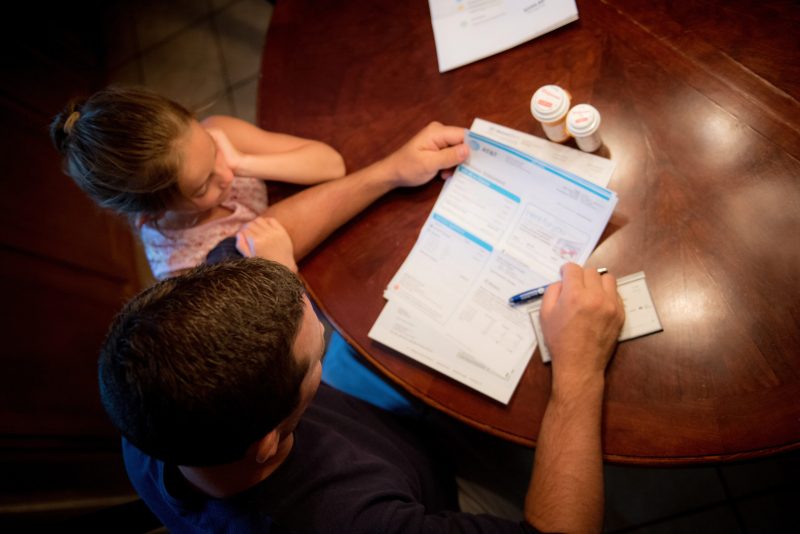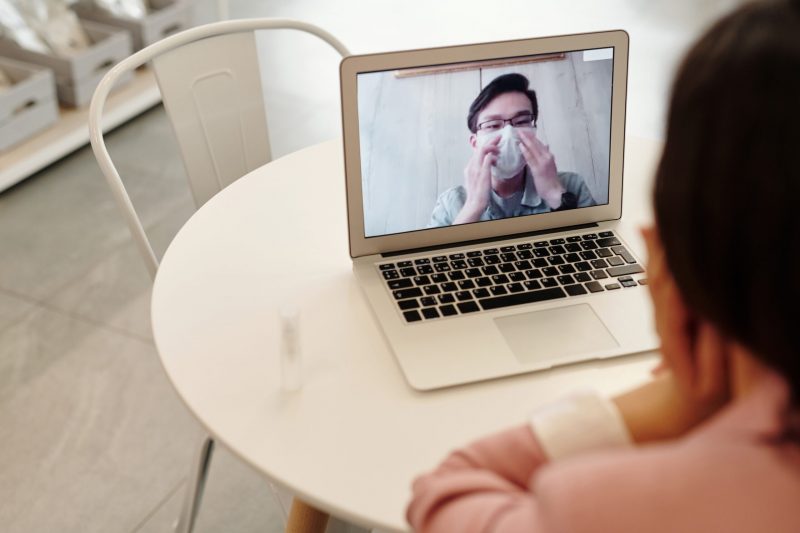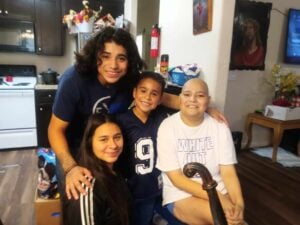
Sights Set on a Strong End to 2023 — Will You Join Us?
Family Reach CEO Carla Tardif reflects on 2023 and calls for community support before the year ends.
A cancer diagnosis is never easy news to hear, and for many, the cost of treatment is just as worrisome as the prognosis. Patients are hit with huge medical bills that threaten to wipe out their savings and then some, and they still have to pay for everyday essentials while they endure the physical and emotional side effects of treatment.
When a crisis as serious as COVID-19 touches all corners of the nation, everyone begins to worry about how much their health insurance will cover if they end up in the hospital. Those who don’t have health insurance often shy away from reporting their symptoms to their doctor for fear of not being able to afford the copay or prescription medicines, which can be especially dangerous when there’s an unfamiliar virus circulating our communities.
The reality is the healthcare system in our country repeatedly fails cancer patients and their families, leaving them in damaging financial situations. But are the answers in places like the UK where the government covers medical bills? Does financial toxicity caused by cancer look different in the UK than it does in the US?
We got perspectives from both sides of the pond to help us understand what we can learn from each other.
John Sweetenham, MD, Associate Director for Clinical Affairs at UT Southwestern’s Simmons Comprehensive Cancer Center, began his oncology career in England before moving to the States where he has worked for over 20 years.
“There is a level of security that people in the UK enjoy because they know the potentially overwhelming cost of treatment, patient visits, and prescriptions does not fall on them,” Dr. Sweetenham explained. “That said, all the other indirect costs of cancer care, like taking time off work and paying for travel to treatment centers, affect patients similarly in both places.”
So, while patients in both the US and the UK experience elements of financial toxicity, the biggest differences stem from health coverage. In America, people must pay for private health insurance if they want to be covered, and many save on the steep cost by getting insured through their employer. In the UK, all citizens are covered by the universal National Health Service.
Essentially, Americans are responsible for paying large bills for cancer treatment, while the National Health Service provides a strong buffer against those immediate costs. Dr. Michelle Cummins, pediatric hematologist at University Hospitals Bristol and Weston NHS Foundation Trust, works with young leukemia patients in England whose families do not have to consider the hefty price tag of the cancer therapy their doctor prescribes.
“I honestly can’t imagine the burden this puts on families in the US and the potential inequalities it creates,” she shared.

However, there are also considerable downsides of the NHS. Many treatments in the UK go through rigorous, and often slow, approval processes, which means it can take longer for new treatments and clinical trials to reach patients.
“There’s a lot of good about the system in the UK in terms of protecting patients from more devastating financial hardship, but the price they pay is the higher level of constraint and control on what is available to patients,” Dr. Sweetenham said.
And even without the steep medical costs, patients in the UK still experience the indirect financial side effects we see American families face. Jacob Sheard, student social worker at Royal Holloway University of London, has witnessed this firsthand through his work with charities in the cancer space like CLIC Sargent.
“Many of the families I’ve worked with have voiced their financial concerns, especially because one or both parents often had to stop working,” he explained. “Travel costs is a big one, especially because many patients have to travel from outside of London into the city using their own cars or public transport. Being away from home for treatment also means their only options for food are expensive takeaways and hospital cafeteria meals, which adds up really quickly.”
Knowing that so many cancer patients experience a significant cost burden during treatment, Dr. Sweetenham advises his fellow oncologists to brush up on their financial knowledge, specifically the options their care centers or nonprofits like Family Reach provide for patients who have cost concerns.
“As physicians, our primary role is to be the advocate for the patient in terms of determining what we think gives them the best chance of recovering,” he said. “However, there’s a very significant return on the initial investment in time to learn about financial resources for cancer patients.”
Still, Dr. Sweetenham knows we can’t expect oncologists or social workers to ever have enough expertise to give patients all the financial advice they need. At the Simmons Cancer Center, his team is working toward ensuring every patient who receives treatment meets with a financial navigator to better understand the financial side of their diagnosis, as well as learn about relevant resources and support services.
When in doubt, Dr. Sweetenham says: “If you feel out of your comfort zone discussing financial toxicity with your patients, find somebody who is not out of their comfort zone to help you.”
Over in England, Dr. Cummins also refers her patients to those with more financial knowledge.
“Here, social workers can help patients apply for charitable grants and government disability benefits,” Dr. Cummins said. “Charitable organizations are especially key for patients and families coping with the financial worry of a cancer diagnosis.”
While changes at a higher level are necessary to overcome financial toxicity before it even has a chance to threaten a patient’s road to recovery, talking with patients about the financial side of their diagnosis is an immediate step in the right direction. Whether it comes from a conversation with their oncologist, nurse, social worker, family member, or a Family Reach Resource Navigator, patients need to know they are not alone and there are resources out there to help.
Universal health coverage or not, the spread of COVID-19 is seriously testing healthcare systems across the world. Being on the frontlines is common ground for oncologists in both the US and UK, and they’re all experiencing changes in cancer care in response to the pandemic. Guidelines from organizations like the American Society of Clinical Oncology advise oncologists on how to make fair and objective decisions to ensure ethical prioritization of care, recommending that patients be included in the conversations and decision-making.
“The pandemic is giving everyone a slightly better understanding of what it’s like to be in a situation where healthcare resources get stretched to the limit,” said Dr. Sweetenham.

From Sheard’s and Dr. Cummins’ perspectives, the healthcare system in the UK is experiencing a similar challenge of providing cancer care in a time of increased demands and strained resources. What’s more, cancer patients in both countries are experiencing overriding anxiety about the virus, including increased financial concerns.
“All children and adults with cancer are considered an extremely vulnerable group during this crisis, and the NHS recommends that they be ‘shielded’ at home for at least 12 weeks,” Dr. Cummins explained. “This means many parents and caregivers have had to work from home or stop working and apply for the government Coronavirus Job Retention Scheme like many others around the country.”
While financial resources are stretched thin, the rapid shift to telemedicine in response to COVID-19 could be a light at the end of the tunnel. Dr. Sweetenham estimated that 80-90% of patient visits at the Simmons Cancer Center are now virtual, and his team is finding that many patients and providers aren’t opposed to the change. Utilizing technology in the future could be an effective way to cut down on indirect costs for patients, such as transportation to the treatment center, plus parking and food costs while at the hospital.
No matter the country, it’s evident that financial hardship is a serious side effect of cancer for patients. As healthcare professionals and government executives in both the US and UK navigate this new world brought on by COVID-19, we can come together in the hope that this unprecedented health crisis will spark solutions that benefit the cancer community in the long run.

Always walking the fine line between her right and left brain, Stevie brings her creative and strategic thinking to her role as Senior Creative and Brand Manager. Her work amplifies Family Reach’s voice and brings attention to the financial impacts of a cancer diagnosis.

Family Reach CEO Carla Tardif reflects on 2023 and calls for community support before the year ends.

Your holiday giving provides financial relief to families like these who are facing cancer this winter.

Curious what a donation to Family Reach does? Here’s a breakdown of how donations to Family Reach provide financial support to families facing cancer.
Applications will only be reviewed and processed for open funds.
Applications will only be reviewed and processed for open funds.
Applications will only be reviewed and processed for open funds.
Applications will only be reviewed and processed for open funds.
Applications will only be reviewed and processed for open funds.
Join our email list for updates about our events, fundraising campaigns, family stories, partnerships, and the impact of your generous support.